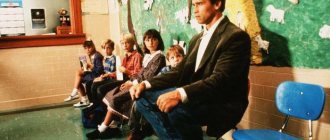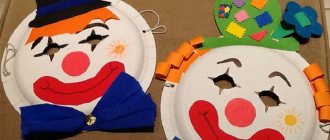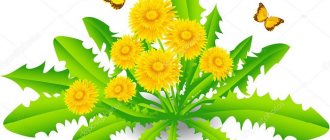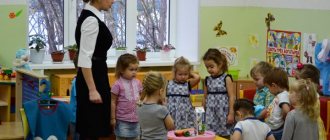Summary of a comprehensive lesson in the second junior group “Winter has come”
Summary of a comprehensive lesson in the second junior group “Winter has come” Goal: to activate the cognitive, speech and visual activity of children; to form a generalized idea of the life of birds in winter.
Software tasks:
- consolidate knowledge about winter;
- consolidate knowledge about clothing items;
— activate the dictionary;
-develop a sense of kindness, a desire to take care of birds.
Materials: pictures with items of clothing (tights, socks, pants, hat, scarf, fur coat, mittens and boots), cards and illustrations depicting a dove, titmouse, sparrow, magpie; wood drawing, snowflakes, glue, brushes, napkins.
Progress of the lesson
Educator: Guys, did you notice on the way to kindergarten how cold it was outside? And why?
Children: Because it’s winter outside.
Educator: that’s right, what should you wear to keep from freezing? Children: clothes
Educator: Who will name her for me? Name... items of clothing and show them (they show, explain which parts of the body to put them on).
Educator: Well done! We won’t freeze if we put on warm clothes, and if we start to freeze, we’ll warm ourselves up:
Physical school
We'll warm up a little, We'll clap our hands. Clap, clap, clap. We put on mittens, We are not afraid of the blizzard. Yes Yes Yes. We'll warm our feet too, We'll jump soon, Yes, yes, yes. We'll warm our feet too, We'll jump soon. Jump, jump, jump. The frost and I became friends, Like snowflakes swirling. So so so.
Educator: Why is it white outside in winter? What's on the ground?
Children: There is snow on the ground.
Educator: Right, what kind of snow?
Children: Light, cold, white.
Educator: And when it snows a lot, what is this phenomenon called?
Children: Snowfall
Educator: And if a strong wind blows during a snowfall, what will happen?
Children: Vyuga
Game “Snowflakes and the Wind” (Children gather in a circle and join hands. At the adult’s signal: “The wind blew strong, strong. Scatter, snowflakes!” - they scatter in different directions, spread their arms to the sides, sway, spin. The adult says: "The wind has died down! Come back, snowflakes, to the circle!" Children run into a circle and join hands.)
Educator: Look carefully, what else do the children do in the winter in the picture? What is the boy doing? What else can you ride in winter?
Zimushka - Winter comes to visit us every year. If you look out the window, you can see how white it is. If you go outside, you can feel how cold it is.
Although it is cold outside in winter, you can come up with many different games, fun and entertainment. What can you do when it snows? (Look at snowflakes on your fur coat, catch snowflakes, shovel snow, clean paths, etc.) What can you do when the snow is wet? (Play snowballs, build a fort, fences, sculpt a snowman, etc.) What can you do when it’s cold and you need to warm up? (Run along the paths, ride each other on a sled, go skiing, etc.) What games can you come up with with snow? (Bake pies, build houses,
Educator: Do you remember who flies to our site?
Educator: Why do many birds fly to warmer climes?
Children: Because they are afraid of the cold, and they cannot get enough food for themselves.
Educator: What is the name in one word for birds that fly away?
Children: Migratory.
Educator: Guys, do all the birds fly away?
Children: No, not all, some remain.
Educator: Look what a beautiful bird it is - a magpie. Repeat.
Children: Magpie.
Educator: What kind of breast does a magpie have? What is it also called?
Educator: Another bird flew to us, a titmouse. Repeat.
Children: Titmouse.
Educator: What kind of breast does a titmouse have?
Children: Yellow.
Educator: And this is a big bird, a dove. What dove? The dove is also called the sizar. Repeat
Children: Sisari.
Educator: Guys, it’s very cold outside, the wind is blowing. Our birds want to eat. Remember what we fed the birds on our walk?
Children: Bread crumbs, seeds.
Bottom line
-Did you like the lesson? What new have you learned? And now I suggest you decorate our tree with snowflakes so that it doesn’t feel cold and lonely.
(collective activity of children)
Toys. Lesson notes - OOD on speech development in the second group of early age “Find a toy”
Publication “OOD on speech development in the second group of early age “Find...” Purpose. Encourage children, according to an adult, to find and show toys and tasks. Educational. Teach children to arrange objects by color. Developmental. Develop: • fine motor skills, • the ability to hold a ball and roll it in your palm. Educational. Cultivate interest and positive…
Summary of a lesson on cognitive development “toys in places” in an early age group
Summary of a lesson on cognitive development “toys in places” in an early age group. Program content: 1. Correlate objects with real objects of different sizes. 2. Clarify the actions performed with these objects (balls roll, jump, cubes can be...
Summary of GCD for speech development with young children "New Year's toys" GCD "New Year's toy" Early age group Topic: "New Year's toy" GCD for speech development within the framework of a comprehensive thematic week "Christmas tree - green needle" Purpose: to introduce the types of Christmas tree toys. Objectives: - continue to develop knowledge about the names of objects...
Notes on drawing "Toys" for young children Notes on drawing "Toys" Program content: Practice drawing round objects. Strengthen the ability to use gouache and hold the brush correctly. Learn to rinse your brush after finishing work. Learn to enjoy your drawings, name the objects depicted and...
Complex classes in the first junior group
Evgenia Fedorova
Complex classes in the first junior group
Lesson No. 1
Topic: 1. Speech game <<Who is telling?>>
2. Mathematical game <<Find all... >>
Target . 1. Strengthen the child’s ability to distinguish vegetables and fruits by appearance, develop auditory attention.
2. Consolidate knowledge of color, shape, size.
Developmental environment : Models of fruits and vegetables on a tray (apple, cucumber, carrot, etc.) magic multi-colored ropes (strips of adhesive tape 3 mm wide, carpet, geometric shapes
Content.
The teacher shows the children fruits and vegetables, invites them to take one item from the tray and name it: “I have an apple!” I have carrots! I have a big cucumber! And I have a small cucumber!>>
The teacher places one of the children next to him and with his back to the others (Fruits and vegetables are again on the tray). One of the children comes to the table, takes a fruit or vegetable from the tray and says: “I took and am holding an apple in my hand.” Then he puts it on the tray and returns it to its place. <<Guess who held an apple in his hand and told you about it?>>, asks the teacher.
If a child recognizes a friend by voice, everyone claps their hands, and the recognized one takes the place of the driver. If the child makes a mistake, he drives again.
Then the teacher invites the children onto the carpet, marks several circles with multi-colored ropes and says that these are houses in which different figures live. in one of them live large blue figures, and in the other triangular red ones, in the third there are large round figures (objects). Children select the figures and “place” them in the corresponding house (circle). The teacher praises the children and says that the children helped to correctly place all the figures in their homes.
Lesson No. 2
Topic: 1. Speech game <<Captains>>
2. Mathematical game <<What's extra? >>
Target. 1. Develop the ability to pronounce the sound [F] for a long time on one exhalation and repeatedly pronounce the sound [p] (p-p-p) on one exhalation.
2. Learn to identify similarities and differences between objects.
Developmental environment: Bowls of water and paper boats, several small red cubes and one green, one large red cube.
Content.
The children have basins of water and paper boats on their tables. Children sit on chairs and blow on the boats, pronouncing the sound [f] or [p].
The teacher explains that in order for the boat to move, you need to blow slowly, as to pronounce the sound [F], then the boat, with an even wind, moves smoothly and confidently.
“But then a gusty wind came,” says the teacher, “it blows unevenly: <<p-p-p>>
The teacher makes sure that when pronouncing the sounds [F] and [P], the child does not puff out his cheeks, but pronounces the sound [p] 2-3 times in one exhalation.
Finishing the game, the children and teacher sing together:
Wind-breeze,
Pull up the sail!
You drive the boat
To the huge river!
Next, the teacher draws the children’s attention to a large red cube and several small red cubes displayed on the carpet.
Questions.
What's on the carpet?
What color are they?
How many are there?
Which cube do you think is the odd one out? Why? (Big, since he is alone, and the rest are small) Then the teacher invites the children to close their eyes and adds one small
Summary of a game lesson in the younger group
Game activity in kindergarten for children of primary preschool age
Theme: Red and blue. Snakes
Demo material:
- toy snake;
- rope in a dark bag;
- a box with objects that are clearly distinguished by their surface: soft fur, a piece of cold leather, rough sandpaper, a soft toy, a wooden tablet, a smooth stone, velvet paper, a piece of silk fabric, rustling tracing paper, etc.;
- audio recording of cheerful music.
Handout:
- for each child, ribbons 15-20 cm long, blue or red;
- plasticine of different colors;
- boards for modeling.
* * *
Organizing time
Meet the children, say hello to each child. Note what color clothes they are wearing.
Physical school
Develops voluntary attention and the ability to imitate the words of a poem.
Together with the children, go through the motions of the poem.
They stomped their feet, they stomp.
They stamped their feet. They stamp their feet.
This is the boot. The legs are put out one by one.
Dance with me, my friend . Spin around.
Surprise moment
Educator
. Guys, do you hear someone hissing: “sh-sh-sh.” Who is this? Snake!
A toy snake crawls into the room. Greets children. You ask the snake if it will bite children. The snake says that it is kind and does not bite anyone. Then the children get to know her.
Sports games with ribbons
Develop basic movements.
Give each child a ribbon (snake). Children repeat the movements after you: lift the ribbon up; They lower them down, spread their arms to the sides, transfer the ribbon from one hand to the other, and spin around with them. Children sit on the floor and show how a snake can crawl along their legs, arms, shoulders, etc.
Educational game “Blue and red ribbons”
Teaches you to distinguish colors and act depending on a given color.
Snake.
Red snakes, climb higher.
Children who have red ribbons raise them up. Then a command sounds for the blue snakes. The game is repeated several times.
Didactic game “Laying out a snake”
Teaches how to apply one object to another, develops fine motor skills of the fingers.
The snake suggests making one long snake from the snakes. Children lay out their snakes one after another. Sports games with rope
Develop basic movements.
The snake quickly collects the resulting long snake from small ribbons and puts it in a bag (which already contains the rope). The snake pretends to cast a spell.
Snake
. Shish-la, shish-la - it turns out to be a snake.
Open the bag and slowly take out the long “snake” (rope).
The rope is laid out on the floor, and children learn to carefully step over it. The rope rises and the children cross over again.
The rope is rolled into a ring, the children jump in and out of the circle.
And finally - tug of war. Divide the children into two teams and explain what to do.
Race walking “Long Snake”
Develops basic movements.
Children hold hands, forming a long snake, and follow you around the room in a circle, every now and then turning in one direction or the other.
Educational game “Long - short snake”
Teaches you to visually understand the words “long - short”.
Children show with their hands the dimensions of a long (spread their arms to the sides) and short (show a small distance between two palms) snake.
Didactic game “Touch the object”
Teaches you to use your fingertips to identify different surfaces by touch and develops tactile sensations.
The snake shows the children its wealth: a box with various objects for touching. She takes out one item at a time.
Snake.
Feel what the rough paper is (hands the velvet paper to the children), touch what the soft toy is, etc.
Outdoor game “Tag with a snake”
Promotes physical activity and relieves impulsiveness, develops gaming skills and arbitrariness of behavior.
Cheerful music is playing, children are running, jumping and having fun. The music stops, the children must squat down and hide (so that the snake does not notice them). A snake crawls past the children. For this game, children will need endurance so as not to run away from the snake.
The game is repeated several times.
Modeling from plasticine “Snakes”
The task involves rolling out long sausages.
The snake offers to make a lot of girlfriends for her - snakes. Children roll a piece of plasticine into a ball, and then into a sausage and give the resulting snake a wave-like shape (they bend the plasticine in several places).
Recommendations for home
Advise parents to look at an album with photographs and videos at home with their child; encourage the child to show people he knows in photographs and videos; Read the fairy tale “Ryaba Hen” several times.







